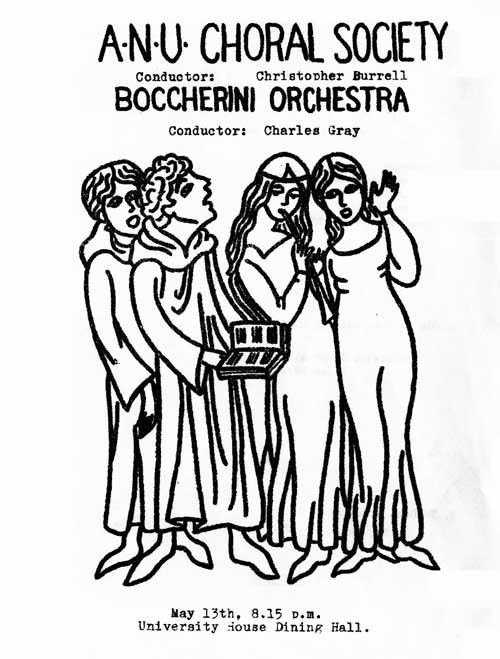

SCUNA history » Concerts » 1969 - 1

A·N·U· CHORAL SOCIETY
Conductor: Christopher Burrell
BOCCHERINI ORCHESTRA
Conductor: Charles Gray
May 13th, 8.15 p.m.
University House Dining Hall
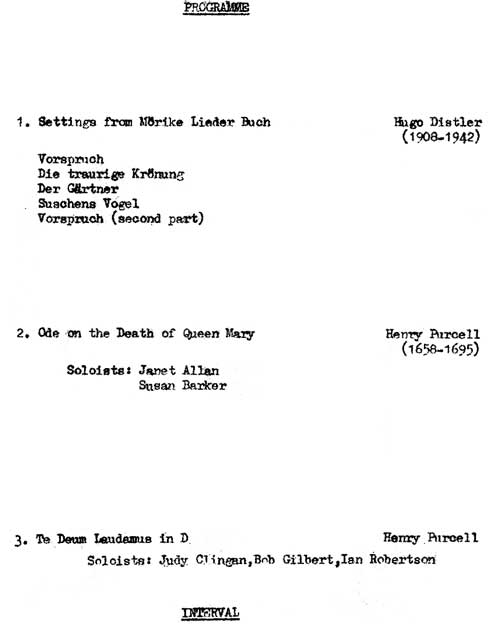
| PROGRAMME | ||||
| 1. | Settings from Mörike Lieder Buch | Hugo Distler (1908-1942) |
||
| Vorspruch Die traurige Krönung Der Gärtner Suschens Vogel Vorspruch (second part) |
||||
| 2. | Ode on the Death of Queen Mary | Henry Purcell (1658-1695) |
||
| Soloists: | Janet Allan Susan Barker |
|||
| 3. | Te Deum Laudamus in D | Henry Purcell | ||
| Soloists: | Judy Clingan, Bob Gilbert, Ian Robertson | |||
| INTERVAL | ||||
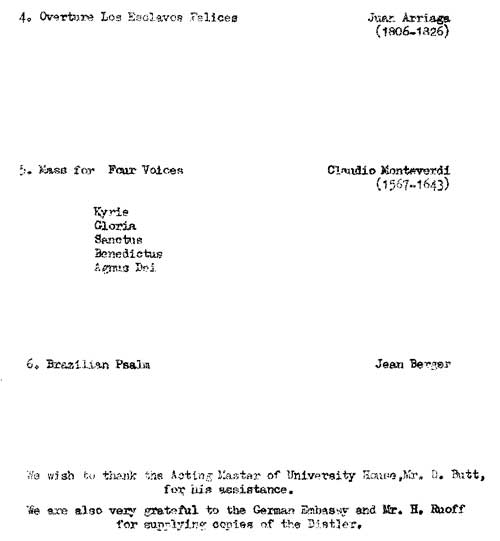
| 4. | Overture Los Esclavos Felices | Juan Arriaga (1806-1826) |
|
| 5. | Mass for Four Voices | Claudio Monteverdi (1567-1643) |
|
| Kyrie Gloria Sanctus Benedictus Agnus Dei |
|||
| 6. | Brazilian Psalm | Jean Berger | |
We wish to thank the Acting Master of University House, Mr D. Butt,
for his assistance.
We are also very grateful to the German Embassy and Mr H. Ruoff
for supplying copies of the Distler.
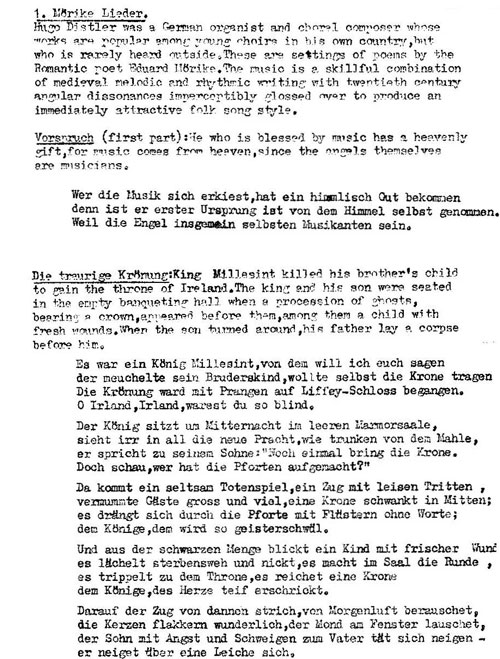
1. Mörike Lieder
Hugo Distler was a German organist and choral composer whose works are popular among young choirs in his own country, but who is rarely heard outside. These are settings of poems by the Romantic poet Eduard Mörike. The music is a skilful combination of medieval melodic and rhythmic writing with twentieth century angular dissonances imperceptibly glossed over to produce an immediately attractive folk song style.
Vorspruch (first part): He who is blessed by music has a heavenly gift, for music comes from heaven, since the angels themselves are musicians.
Wer die Musik sich erkiest, hat ein himmlisch Gut bekommen
Denn ihr erster Ursprung ist von dem Himmel selbst genommen.
Weil die Engel insgemein selbsten Musikanten sein.
Die traurige Krönung: King Millesint killed his brother's child to gain the throne of Ireland. The king and his son were seated in the empty banqueting hall when a procession of ghosts, bearing a crown, appeared before them, among them a child with fresh wounds. When the son turned around, his father lay a corpse before him.
Es war ein König Millesint, von dem will ich euch sagen:
der meuchelte sein Bruderskind, wollte selbst die Krone tragen.
Die Krönung ward mit Prangen auf Liffey-Schloss begangen.
O Irland! Irland! warest du so blind?
Der König sitzt um Mitternacht im leeren Marmorsaale,
sieht irr in all die neue Pracht, wie trunken von dem Mahle;
er spricht zu seinem Sohne: "Noch einmal bring die Krone.
Doch schau, wer had die Pforten aufgemacht?"
Da kommt ein seltsam Totenspiel, ein Zug mit leisen Tritten,
vermummte Gäste groß and viel, eine Krone schwankt in Mitten;
es drängt sich durch die Pforte mit Flüstern ohne Worte;
dem Könige, dem wird so geisterschwül.
Und aus der schwarzen Menge blickt ein Kind mit frischer Wunde,
es lächelt sterbensweh and nickt, es macht im Saal die Runde,
es trippelt zu dem Throne, es reichet eine Krone
dem Könige, des Herze tief erschrickt.
Darauf der Zug von dannen strich, von Morgenluft berauschet,
die Kerzen flackern wunderlich, der Mond am Fenster lauschet,
der Sohn mit Angst and Schweigen zum Vater tät sich neigen -
er neiget über eine Leiche sich.
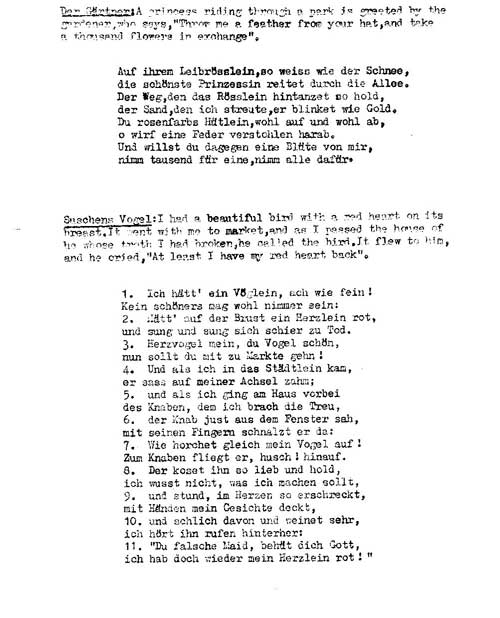
Der Gärtner: A princess riding through a park is greeted by the gardener, who says, "Throw me a feather from your hat, and take a thousand flowers in exchange".
Auf ihrem Leibrösslein, so weiss wie der Schnee,
die schönste Prinzessin reitet durch die Allee.
Der Weg, den das Rösslein hintanzet so hold,
der Sand, den ich streute, er blinket wie Gold!
Du rosenfarb's Hütlein wohl auf und wohl ab,
O wirf eine Feder verstohlen herab!
Und willst du dagegen eine Blüte von mir,
nimm tausend für eine, nimm alle dafür!
Suschens Vogel: I had a beautiful bird with a red heart on its breast. It went with me to market, and as I passed the house of he whose troth I had broken, he called the bird. It flew to him, and he cried, "At last I have my red heart back".
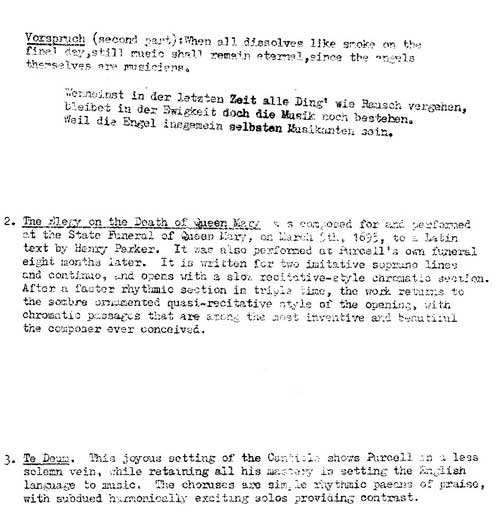
Vorspruch (second part): When all dissolves like smoke on the final day, still music shall remain eternal, since the angels themselves are musicians.
Wenn einst in der letzten Zeit alle Ding' wie Rauch vergehen,
Bleibet in der Ewigkeit doch die Musik noch bestehen,
Weil die Engel insgemein selbsten Musikanten sein.
2. The Elegy on the death of Queen Mary was composed for and performed at the State Funeral of Queen Mary, on March 5th, 1695, to a Latin text by Henry Parker. It was also performed at Purcell's own funeral eight months later. It is written for two imitative soprano lines and continuo, and opens with a slow recitative-style chromatic section. After a faster rhythmic section in triple time, the work returns to the sombre ornamented quasi-recitative style of the opening, with chromatic passages that are among the most inventive and beautiful the composer ever conceived.
3. Te Deum: This joyous setting of the Canticle shows Purcell in a less solemn vein, while retaining all his mastery in setting the English language to music. The choruses are simple rhythmic paeans of praise, with subdued harmonically exciting solos providing contrast.
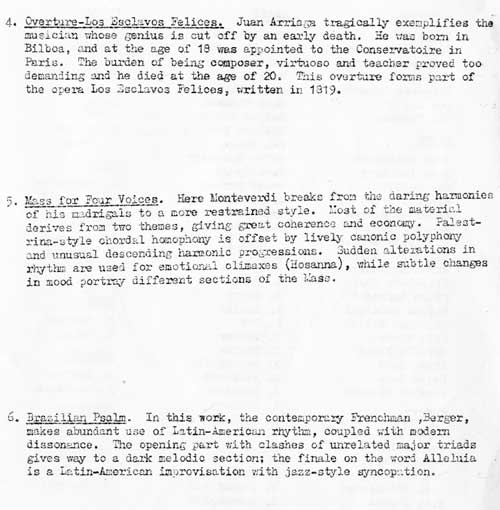
4. Overture-Los Esclavos Felices. Juan Arriaga tragically exemplifies the musician whose genius is cut off by an early death. He was born in Bilboa, and at the age of 18 was appointed to the Conservatoire in Paris. The burden of being composer, virtuoso and teacher proved too demanding and he died at the age of 20. This overture forms part of the opera Los Esclavos Felices, written in 1819.
5. Mass for Four Voices. Here Monteverdi breaks from the daring harmonies of his madrigals to a more restrained style. Most of the material derives from two themes, giving great coherence and economy. Palestrina-style chordal homophony is offset by lively canonic polyphony and unusual descending harmonic progressions. Sudden alterations in rhythm are used for emotional climaxes (Hosanna), while subtle changes in mood portray different sections of the Mass.
6. Brazilian Psalm. In this work, the contemporary Frenchman, Berger, makes abundant use of Latin-American rhythm, coupled with modern dissonance. The opening part with clashes of unrelated major triads gives way to a dark melodic section; the finale on the word Alleluia is a Latin-American improvisation with jazz-style syncopation.
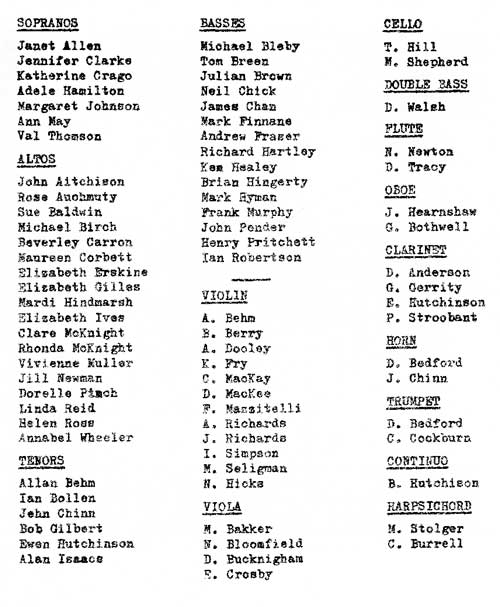
| SOPRANOS Janet Allen Jennifer Clarke Katherine Crago Adele Hamilton Margaret Johnson Ann May Val Thomson ALTOS John Aitchison Rose Auchmuty Sue Baldwin Michael Birch Beverly Carron Maureen Corbett Elizabeth Erskine Elizabeth Gilles Mardi Hindmarsh Elizabeth Ives Clare McKnight Rhonda McKnight Vivienne Muller Jill Newman Dorelle Pinch Linda Reid Helen Ross Annabel Wheeler TENORS Allan Behm Ian Bollen Jehn Chinn Bob Gilbert Ewen Hutchinson Alan Isaacs |
BASSES Michael Bleby Tom Breen Julian Brown Neil Chick James Chan Mark Finnane Andrew Fraser Richard Hartley Ken Healey Brian Hingerty Mark Hyman Frank Murphy John Pender Henry Pritchett Ian Robertson ------- VIOLIN A. Behm B. Berry A. Dooley K. Fry C. MacKay D. MacKee F. Mazzitelli A. Richards J. Richards I. Simpson M. Seligman N. Hicks VIOLA M. Bakker N. Bloomfield D. Buckingham E. Crosby |
CELLO T. Hill M. Shepherd DOUBLE BASS D. Walsh FLUTE N. Newton D. Tracy OBOE J. Hearnshaw G. Bothwell CLARINET D. Anderson G. Gerrity B. Hutchinson P. Stroobant HORN D. Bedford J. Chinn TRUMPET D. Bedford C. Cockburn CONTINUO B. Hutchison HARPSICHORD M. Stolger C. Burrell |
1 Art work by Judith Clingan; transferred to stencil by your humble servant. I may also have typed the programme, or at least some of it. The layout was a (literal) cut-and-paste job of the kind we used to do at the Research School of Chemistry in the dead of night. Barely a straight line to be seen!
2 Judith Clingan played bassoon when not singing.
I'm indebted to Michael Bleby for supplying the three pages I was missing from this programme.